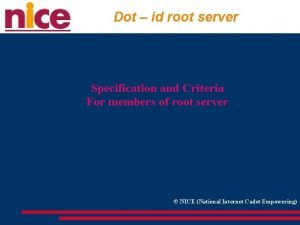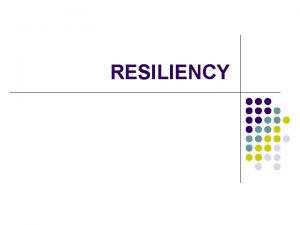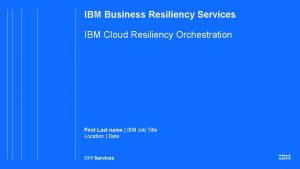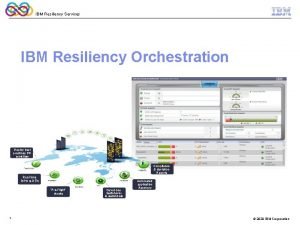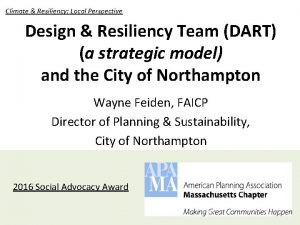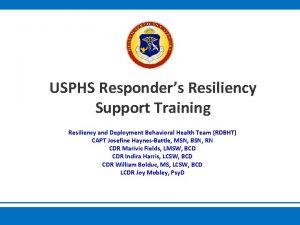Overview of Completed TTITx DOT Resiliency Workshops Jolanda
















- Slides: 16

Overview of Completed TTI/Tx. DOT Resiliency Workshops Jolanda Prozzi 10 December 2020

Presentation Overview • TTI Resiliency Studies • Metropolitan Planning Organization (MPO) Resiliency Planning Practices • Resiliency Lessons Learned • Resiliency Workshop Recommendations 2

TTI Resiliency Studies • Vulnerable Freight Infrastructure in Texas (Texas Legislature) • Applying Resilience Theory to Transportation Problems (Tx. DOT) • Update Rainfall Coefficients with 2018 NOAA Atlas 14 Rainfall Data (Tx. DOT) • Developing a Resilient Texas Transportation System (Tx. DOT) • Asset Management, Extreme Weather, and Proxy Indicators (FHWA Pilot Project) • Addressing Resiliency in Regional Transportation Plans (Tx. DOT) • Resilience and Durability to Extreme Weather in the H-GAC Region Pilot Project (HGAC) 3

MPO Resiliency Planning Practices • MPO web survey to document best practices in planning for resiliency • Focus on enhancing planning of – resilient regional transportation systems to climate change and extreme weather events • Surveys disseminated over a 3 -month period – February 11, 2019 through May 9, 2019 • 57 MPOs provided complete and usable survey responses 4 4

Resiliency – Definitions, Goals and Metrics Resiliency Definition Resiliency Goals Resiliency Metrics One third had defined resiliency One in three had defined resiliency goals One fifth had defined resiliency metrics § Reasons for not defining resiliency: § Reasons for not defining resiliency goals: § Reasons for not defining resiliency metrics: § About half stated it is a work in progress § Three of ten stated it is a work in progress § About one in four stated it is a work in progress § About one in ten stated it is on radar but not a priority § One in five stated it will be in next MTP § 15 percent stated it was on radar but not a priority § About one in ten stated that while not formally defined, their MTP includes elements of resiliency § One in five stated that it is on radar but not a priority § 13 percent stated it will be in next MTP § 13 percent stated more Federal guidance is needed Bottom Line About one in ten (12 percent) have defined resiliency, identified resiliency goals, and developed resiliency metrics to measure progress toward resiliency goals. 5 5

MPO Comments “We don't have the resources to do this type of work in a way that would result in a more meaningful or robust actions to improve resiliency. Given the work we have done to date and the challenges of the data, analysis tools and wide range of possible results, I would expect our updated plan will include broad language and policies suggesting owners of the transportation system should include this type of planning and analysis. Also the regional plan may include suggested actions/strategies but measure when and how those actions could make a significant difference is beyond our current resources. ” “We are a small MPO and currently have only two FTEs. However, as stated previously we plan to address resiliency in a meaningful way in the near future. This will include a fulsome discussion in our upcoming 2045 RTP. ” “Small agencies have significant challenges both budgetary and staff related in defining, measuring and developing resilience plans” 6 6

Preparing for Climate Change/Extreme Events Identified Climate Factors & Assessed Vulnerability 44 percent had identified climate factors and assessed vulnerability of RTS to these factors § Reasons for not doing so: § Three of ten state it is a work in progress § About one in four state a lack of resources (FTEs or funding or both) Identified RTS Critical Elements Determined Response to Event Determined Likelihood of Event Seven of ten had identified RTS critical elements One third had determined response to extreme weather event One third had determined likelihood of extreme weather event § Reasons for not doing so: § Three of four state it is a work in progress § One third state it is a work in progress § 18 percent stated it was on radar but not a priority § Three of ten stated responsibility for this lied elsewhere § About one in ten stated responsibility for this lied elsewhere § One fourth stated this responsibility lied elsewhere § One of five state it is a work in progress § 16 percent state a lack of resources (FTEs or funding or both) Bottom Line § About one in ten (11 percent) have (1) identified & characterized climate factors that might impact RTS & assessed vulnerability of their RTS to climate change/extreme weather events, (2) identified critical elements of their RTS, (3) determined how their RTS will respond to an extreme weather event, and (4) determined the risks/likelihood of extreme weather events occurring. 7 7

Climate Factors • 76% of respondents identified precipitation/flooding as climate factor of most significant concern. – Most used data to assess impact of extreme weather events was FEMA floodplain data – Most needed type of data to assess impact of extreme weather events was hydrological data 8 8

Vulnerable Elements of Transportation System Non-motorized infrastructure 11% Land ports of entry 11% Transit infrastructure 16% Maritime ports 16% Other 26% Airports 42% Waterways 42% Rail infrastructure 79% Road connectors 84% Bridges 95% Highway corridors 100% 0% 20% 40% 60% 80% 100% 120% 9 9

Lessons Learned • Frameworks are important Ø Assess risk to specific asset classes and the impacts on those asset classes (failure and disruption) Ø Texas Asset Management Plan = Floodway = 100 yr. flood = 500 yr. flood Intersect all major roads and flood risk areas 10

Lessons Learned • Frameworks are important Ø Understand conceptualize the different components and the interaction of components of the transportation system, as well as system performance Resilient Transportation System 11

Lessons Learned • Frameworks are important Ø Guide the planning, programming, design, construction, and maintenance of the transportation system 12

Lessons Learned • Cross-disciplinary collaboration is important Ø Collaboration among climatologists, hydrologists, pavement engineers, planners, and other transportation domain specialists Ø Workshops are useful to capture different perspectives, but also to share information about available data and models 13

Lessons Learned 3. Data and models/tools are important Ø Data (too much, not enough, not quite right …. ) Ø Tools/models − − − Understanding transportation impacts - more frequent maintenance of culverts, improved drainage, adding shoulders to mitigate flooding on pavement service life (heat? ) Lifecycle planning analysis does not consider the cost and disruption of road closures Tools to link rainfall events to flooding to inundation to pavement impacts 14

Workshop Recommendations • Create Texas Resiliency Work Group • Incorporate Resiliency in Tx. DOT’s Performance‑Based Planning and Programming Process • Implement Resiliency Data Clearinghouse • Host Resiliency Workshops • Resiliency Frameworks • Develop a Scenario Planning Tool The Texas Resiliency Work Group includes: • • • State transportation planners. Multimodal planners (e. g. , maritime, rail and transit). Asset managers. District planners and maintenance personnel. Engineers. Geographic information system specialists. Environmental planners. State climatologists. Metropolitan transportation planners. 15

Questions Jolanda Prozzi j-prozzi@ttimail. tamu. edu 512 584 9143 16
 Id root
Id root Cramped workshops set up in shabby tenement buildings
Cramped workshops set up in shabby tenement buildings Double interview michelle garcia winner
Double interview michelle garcia winner Read 180 lexile chart 2021
Read 180 lexile chart 2021 Canadian bioinformatics workshops
Canadian bioinformatics workshops Danio kwark gezond
Danio kwark gezond Sayville academic center
Sayville academic center Psea retirement workshops
Psea retirement workshops Canadian bioinformatics workshops
Canadian bioinformatics workshops Can665.com
Can665.com Icef toronto
Icef toronto Mbti team building workshops
Mbti team building workshops Canadian bioinformatics workshops
Canadian bioinformatics workshops Oracle licensing workshops
Oracle licensing workshops Canadian bioinformatics workshops
Canadian bioinformatics workshops Rabobank zoetermeer
Rabobank zoetermeer Oh oh oh somarello
Oh oh oh somarello
